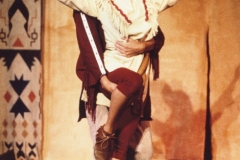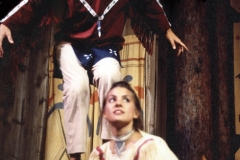
Eleven tales from the roaring lodge fires of Wisconsin and other Native American tribes, brought to life through the “story theatre” method and containing both original and Native American music. The show, performed in AFT’s 1991 season, was directed by legendary Second City director Paul Sills and became the basis for AFT’s 2004 production When Dogs Could Talk. (5 Players)
Door County Advocate
Thursday, July 18, 1991
Wisdom and fun in new park show
The Earth-centered spirituality of the American Indian is portrayed with sensitivity and wit in one of two new shows by American Folklore Theatre. “Moon of the Long Nights” was researched by Dr. Fred Heide and runs each Monday-Wednesday-Friday at the Peninsula Park Amphitheatre, Nicolet Bay.
Heide, who teaches at Cal-Berkeley, literally moonlights as a performer here each summer.
The sketches in “Moon” vary from the tale of a fearsome flying head (who winds up with the mother of all heartburn) to a story of love’s sacrifice. The Ojibway and Oneida, from whose experience the show was taken, enjoy telling stories about Creation, how animals got their characteristics, and how frailties lead to troubles. Not too far from Moliere, or Kipling.
Edward Benton-Banai, an Ojibway of the Lac Court Oreilles band, was a consultant to Dr. Heide in creating the show. He was a co-founder of the American Indian Movement and is superintendent of Lac Courte Oreilles School.
Oneidas from the Green Bay area were also consulted.
AFT is a total experience that starts when you enter the park and doesn’t end till you leave. We saw a beautiful young doe as we left Monday night.
We were going to go Friday but were dissuaded by a black sky. It occurred to us that AFT might go the way of the Peninsula Players and have first a canvas top, then a permanent pavilion. No, that would be a mistake unless the top could be rolled back Skydome style. Particularly for a show like “Moon,” the open sky is part of the set.
The performers are all experienced professionals. Fred Alley, who wrote the Tuesday-Thursday-Saturday show “Tongue ‘n Cheek,” is back after a season off, Jeff Herbst after two. Herbst, by the way, is a Sioux.
Suzanne Graf [sic] is a New Yorker but Badger-born. The only cast member not raised in Wisconsin is Deborah Alden, a Bay stater. Deborah is probably the cutest white Indian since Debra Paget. Well, not all white. There’s a touch of Kickapoo in her bloodline according to the program notes.
Important to the show’s success is the tutelage of Paul Sills, a big-time director who just happens to summer in Door County. Sills was the original director of Second City in Chicago and teaches at the New Actors Workshop in Manhattan, a graduate program he founded along with Mike Nichols and George Morrison.
Some AFT (formerly Heritage) shows have been fairly static, singers just doing their thing at the mike. Not “Moon.” The stage movement is abundant and carefully choreographed. From chases that would do credit to French farce to the more serious sketches, the action is an integral part of meaning. Herbst and Graf [sic] have particularly strenuous workouts and Alley’s mini-Arabesques are hilarious. Small children might not get the deeper meanings of Indian lore but they’re tickled by the action.
The Fox chasing the Rabbit is as much fun as Roadrunner’s antics.
Many of the sketches have a moral. A mischievous raccoon teaches a blind couple to trust each other.
Why do dogs sniff under each other’s tails? They’re picking a president. Probably as good as our system.
The most beautiful stories tell of sacrifice, particularly “Why The Oaks Keep Their Leaves.” A man seeks to kill a bear for dowry so he can marry the maiden he loves but he falls under the power of an evil spirit. The oaks speak to each other and give the maiden power to resist the evil captor. The bad spirit has 20-20 and wants the girl for himself. She bargains for her and her fiance’s release with the condition that she will return when the last oak leaf falls in winter. And that’s why the oaks keep their leaves.
It’s that kind of show, upbeat, interesting, great visual. We can see another public TV show coming up to follow Heide’s John Muir show and last season’s Civil War show “Mule for Breakfast Again.”
Give yourself a treat.
P.S. No park stickers required to just drive in for the show and park in the theater lot. –CFH
The Green Bay Press-Gazette
WARREN GERDS - June 1991
Oneida folk tales provide fascinating theater
**** Excellent
FISH CREEK – A swimming rock, a flying head and an owl who marries a maiden are just a few of the richly imaginative characters in a new American Folklore Theatre show being presented this summer.
They’re in Moon of the Long Nights, a compilation of tales drawn mostly from the Oneida and Anishinabe tribes of Wisconsin Indians.
The production is unique.
First, Indian tales lean toward far-out by nature. They’re stuffed full of myth, magic and the supernatural. For instance, a rabbit can turn himself into a tree, or send his moccasins off to mark a false trail by themselves or become a stinky dead rabbit.
American Folklore Theatre, with a 20-year history, is skilled at spicing its original scripts (this one by Frederick Heide) with animation, music and vitality.
For Moon of the Long Nights, the troupe has a director of distinction, Paul Sills. A founding director of Chicago’s Second City comedy troupe, he is a trainer of actors and creator of Story Theatre. The latter encompasses a style of theater in which stories are told through characters rather than a narrator.
Sills’ influences in storytelling and humor are obvious in Moon of the Long Nights. The troupe—Heidi [sic], Fred Alley, Jeffrey Herbst, Suzanne Graff and Deborah Alden—adds tunes (or chants), sound effects and a large dose of zeal.
The result is a night of delights—a “find” for summertime nature lovers and leisure seekers in the middle of the woods in Peninsula State Park.
There’s no “best” tale out of the 11 presented. They move in different ways as they play out a gamut of emotions from love to fear. One is even a tad raunchy, though it is extremely funny as it tells of the unending search by dogs for the most-qualified president. So there no mistake [sic], the show is family entertainment and this tale is unlikely to offend.
Some stories are romantic and tender: The Owl Husband and Why Oak Trees Hold Their Leaves in Wintertime.
One is scary: The Flying Head, in which Herbst roars and rants as a voracious creature hungry for a baby.
Some are just-for-laughs goofy: The Raccoon and the Old Blind Couple, in which the animal teases the human (wearing dark glasses), and The Coyote and the Rock, in which the rock chases the coyote over field and stream.
One is poignant: The Origin of Death.
The tales are quick snippets. The whole show lasts only slightly over an hour. But it is so filled with strange, wonderful, fascinating experiences it seems you’ve been transported for a longer time.


